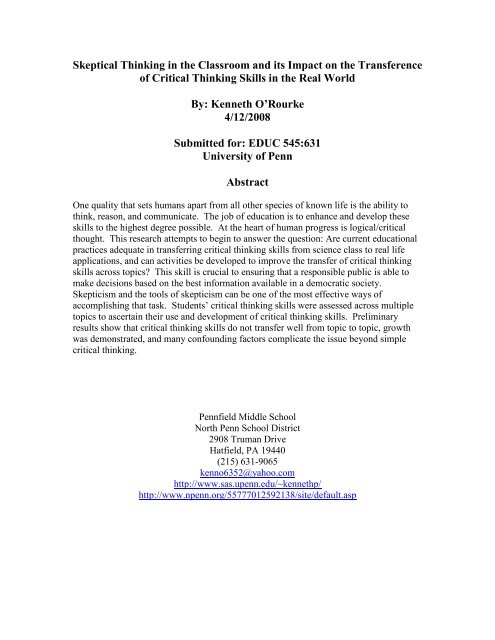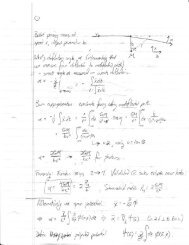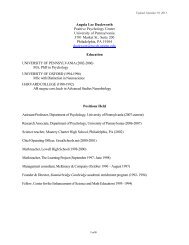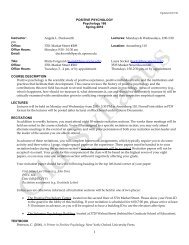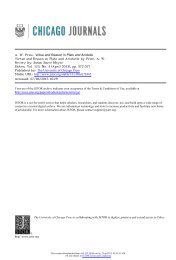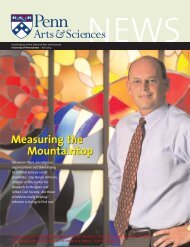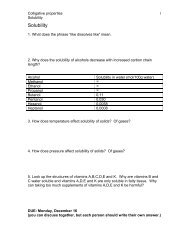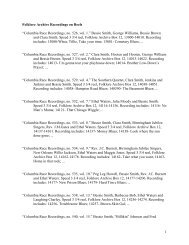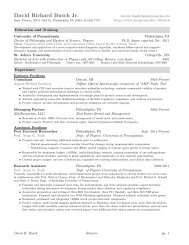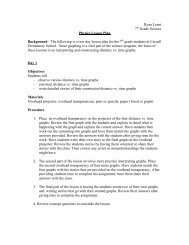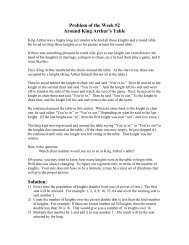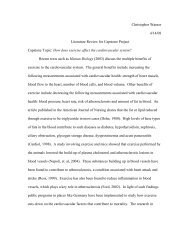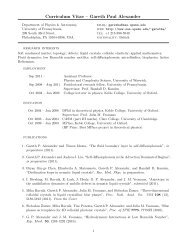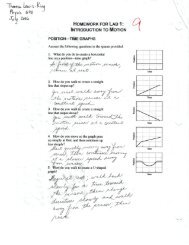Skeptical Thinking in the Classroom and its Impact - School of Arts ...
Skeptical Thinking in the Classroom and its Impact - School of Arts ...
Skeptical Thinking in the Classroom and its Impact - School of Arts ...
Create successful ePaper yourself
Turn your PDF publications into a flip-book with our unique Google optimized e-Paper software.
<strong>Skeptical</strong> <strong>Th<strong>in</strong>k<strong>in</strong>g</strong> <strong>in</strong> <strong>the</strong> <strong>Classroom</strong> <strong>and</strong> <strong>its</strong> <strong>Impact</strong> on <strong>the</strong> Transference<br />
<strong>of</strong> Critical <strong>Th<strong>in</strong>k<strong>in</strong>g</strong> Skills <strong>in</strong> <strong>the</strong> Real World<br />
By: Kenneth O’Rourke<br />
4/12/2008<br />
Submitted for: EDUC 545:631<br />
University <strong>of</strong> Penn<br />
Abstract<br />
One quality that sets humans apart from all o<strong>the</strong>r species <strong>of</strong> known life is <strong>the</strong> ability to<br />
th<strong>in</strong>k, reason, <strong>and</strong> communicate. The job <strong>of</strong> education is to enhance <strong>and</strong> develop <strong>the</strong>se<br />
skills to <strong>the</strong> highest degree possible. At <strong>the</strong> heart <strong>of</strong> human progress is logical/critical<br />
thought. This research attempts to beg<strong>in</strong> to answer <strong>the</strong> question: Are current educational<br />
practices adequate <strong>in</strong> transferr<strong>in</strong>g critical th<strong>in</strong>k<strong>in</strong>g skills from science class to real life<br />
applications, <strong>and</strong> can activities be developed to improve <strong>the</strong> transfer <strong>of</strong> critical th<strong>in</strong>k<strong>in</strong>g<br />
skills across topics? This skill is crucial to ensur<strong>in</strong>g that a responsible public is able to<br />
make decisions based on <strong>the</strong> best <strong>in</strong>formation available <strong>in</strong> a democratic society.<br />
Skepticism <strong>and</strong> <strong>the</strong> tools <strong>of</strong> skepticism can be one <strong>of</strong> <strong>the</strong> most effective ways <strong>of</strong><br />
accomplish<strong>in</strong>g that task. Students’ critical th<strong>in</strong>k<strong>in</strong>g skills were assessed across multiple<br />
topics to ascerta<strong>in</strong> <strong>the</strong>ir use <strong>and</strong> development <strong>of</strong> critical th<strong>in</strong>k<strong>in</strong>g skills. Prelim<strong>in</strong>ary<br />
results show that critical th<strong>in</strong>k<strong>in</strong>g skills do not transfer well from topic to topic, growth<br />
was demonstrated, <strong>and</strong> many confound<strong>in</strong>g factors complicate <strong>the</strong> issue beyond simple<br />
critical th<strong>in</strong>k<strong>in</strong>g.<br />
Pennfield Middle <strong>School</strong><br />
North Penn <strong>School</strong> District<br />
2908 Truman Drive<br />
Hatfield, PA 19440<br />
(215) 631-9065<br />
kenno6352@yahoo.com<br />
http://www.sas.upenn.edu/~kennethp/<br />
http://www.npenn.org/55777012592138/site/default.asp
Background<br />
In a day where science <strong>and</strong> technology has achieved th<strong>in</strong>gs that no one thought humanity<br />
could possibly atta<strong>in</strong> 500 years ago, superstition <strong>and</strong> credulity are still prevalent <strong>in</strong><br />
today’s society much as <strong>the</strong>y were 500 years ago. Science <strong>and</strong> technology seem to be<br />
progress<strong>in</strong>g at an ever <strong>in</strong>creas<strong>in</strong>g rate, <strong>and</strong> every day <strong>the</strong> human race becomes more<br />
dependent on science <strong>and</strong> technology while <strong>the</strong> vast majority <strong>of</strong> <strong>the</strong> general public’s<br />
underst<strong>and</strong><strong>in</strong>g <strong>of</strong> science is sketchy at best. People bask <strong>in</strong> <strong>the</strong> glories that science <strong>and</strong><br />
technology bestow upon <strong>the</strong>m, yet mistrust <strong>and</strong> ridicule scientists as social misf<strong>its</strong>, nerds,<br />
<strong>and</strong> quacks. Diseases like smallpox, which have devastated people for centuries, have<br />
been eradicated. More people are fed today even though <strong>the</strong>re are decreas<strong>in</strong>g amounts <strong>of</strong><br />
farml<strong>and</strong> available to farm. Less than 70 years after <strong>the</strong> first powered flight man had<br />
l<strong>and</strong>ed on <strong>the</strong> moon. In a democratic society <strong>the</strong> people will be elect<strong>in</strong>g representatives<br />
to make political decisions for <strong>the</strong>m. Many <strong>of</strong> <strong>the</strong>se decisions will be on controversial<br />
topics such as: stem cell research, clon<strong>in</strong>g, abortion, <strong>the</strong> space program, global warm<strong>in</strong>g,<br />
alternative energies, nuclear energy, <strong>and</strong> <strong>the</strong> ozone hole, along with problems not named<br />
or as <strong>of</strong> yet undiscovered. The only way <strong>the</strong> public can possibly make wise decisions on<br />
matters such as those is if <strong>the</strong>y have a good underst<strong>and</strong><strong>in</strong>g <strong>of</strong> science, faith <strong>in</strong> <strong>the</strong><br />
scientific method, <strong>the</strong> ability to look at <strong>the</strong> arguments from all sides skeptically, <strong>and</strong> be<br />
able to discern what arguments hold water. Not many people have <strong>the</strong> time to become<br />
versed on all <strong>the</strong> details <strong>of</strong> every topic under scrut<strong>in</strong>y. As a result, <strong>the</strong>y must rely on <strong>the</strong><br />
<strong>in</strong>formation that comes from <strong>the</strong> media, politicians, special <strong>in</strong>terest groups, corporations,<br />
<strong>and</strong> religious leaders. Teach<strong>in</strong>g students to th<strong>in</strong>k skeptically about claims <strong>in</strong> general, <strong>and</strong><br />
how to evaluate <strong>in</strong>formation <strong>in</strong> an objective way so that <strong>the</strong>y can recognize valid<br />
<strong>in</strong>formation from unsubstantiated or mislead<strong>in</strong>g <strong>in</strong>formation, is <strong>the</strong> key to mak<strong>in</strong>g <strong>the</strong><br />
best decisions on any topic. I feel that a student that can evaluate <strong>in</strong>formation <strong>in</strong> a<br />
skeptical <strong>and</strong> logical manner has better tools for life <strong>in</strong> <strong>the</strong> 21 st century than a student that<br />
just knows a lot <strong>of</strong> science facts, formulas, <strong>and</strong> can get <strong>the</strong> correct answer to a problem on<br />
a test. As much as I would love for all my students to leave my classroom with a love <strong>of</strong><br />
science equal to m<strong>in</strong>e, I am not that naïve. Most will not remember how to f<strong>in</strong>d <strong>the</strong><br />
resultant force applied to an object pulled at a 40 degree angle from <strong>the</strong> normal, but if<br />
<strong>the</strong>y learn skeptical/critical th<strong>in</strong>k<strong>in</strong>g skills <strong>the</strong>y will be better scientific th<strong>in</strong>kers that are<br />
better able to make <strong>in</strong>formed decisions especially when it comes to matters hav<strong>in</strong>g to do<br />
with science. I have witnessed how skills are not transferred from one lesson to <strong>the</strong> next<br />
or that <strong>the</strong> skills learned <strong>in</strong> one class does not transfer to ano<strong>the</strong>r class. A common<br />
example <strong>of</strong> this is that students have no problem solv<strong>in</strong>g equations <strong>in</strong> math class, but can<br />
not solve <strong>the</strong> same type <strong>of</strong> problem <strong>in</strong> science class. I believe that logical/critical<br />
th<strong>in</strong>k<strong>in</strong>g skills used <strong>in</strong> <strong>the</strong> classroom are not used or transferred <strong>in</strong> proportion to real life<br />
situations that may require it.<br />
Research Question:<br />
Do critical th<strong>in</strong>k<strong>in</strong>g skills transfer from science class to real life applications, <strong>and</strong> can<br />
activities be developed to improve <strong>the</strong> transfer <strong>of</strong> critical th<strong>in</strong>k<strong>in</strong>g skills across topics?<br />
I am not sure if <strong>the</strong>re is a s<strong>in</strong>gle ma<strong>in</strong> cause for <strong>the</strong> lack <strong>of</strong> critical th<strong>in</strong>k<strong>in</strong>g skills <strong>in</strong><br />
students today. There seems to be several stages <strong>in</strong> <strong>the</strong> development <strong>of</strong> critical th<strong>in</strong>k<strong>in</strong>g
skills as it perta<strong>in</strong>s to belief <strong>and</strong> <strong>the</strong> way <strong>in</strong>formation is evaluated. (Margarita Limón ) I<br />
believe that it is a multitude <strong>of</strong> factors that end up conspir<strong>in</strong>g to make a more credulous<br />
student. Some <strong>of</strong> <strong>the</strong>se may <strong>in</strong>clude:<br />
a) The propagation <strong>of</strong> unsubstantiated claims.<br />
a. Disguised as science o<strong>the</strong>rwise know as pseudoscience. Many times an<br />
idea or event is termed as fact or as hav<strong>in</strong>g been confirmed by science <strong>and</strong><br />
has little or no connection to science. These types <strong>of</strong> claims can mislead<br />
people, leav<strong>in</strong>g <strong>the</strong>m with a greater distrust <strong>of</strong> real science. They are <strong>of</strong>ten<br />
presented <strong>in</strong> a charismatic way with flawed logic <strong>and</strong> no method <strong>of</strong><br />
disprov<strong>in</strong>g <strong>the</strong> claim. People can be fooled because <strong>the</strong> claim makes <strong>the</strong>m<br />
feel good or taps <strong>in</strong>to a desire for that person. They can be made<br />
<strong>in</strong>nocently or with a desire to help, but <strong>of</strong>ten <strong>the</strong>y are made by people that<br />
know <strong>the</strong>y are false to fur<strong>the</strong>r <strong>the</strong>ir agenda.<br />
b. Media outlets that do not check facts or <strong>the</strong> veracity <strong>of</strong> claims. Many<br />
programs <strong>in</strong> <strong>the</strong> media are only <strong>in</strong>terested <strong>in</strong> rat<strong>in</strong>gs, <strong>and</strong> <strong>the</strong> debunk<strong>in</strong>g <strong>of</strong><br />
fallacious claims is usually a casualty <strong>in</strong> <strong>the</strong> rat<strong>in</strong>gs race. Extraord<strong>in</strong>ary<br />
claims will get extraord<strong>in</strong>ary rat<strong>in</strong>gs; however <strong>the</strong> evidence is far less than<br />
extraord<strong>in</strong>ary <strong>and</strong> many times fraudulent.<br />
c. Ascrib<strong>in</strong>g supernatural causes to mundane although uncommon<br />
experiences. People can misperceive th<strong>in</strong>gs <strong>and</strong> come to wrong<br />
conclusions. When <strong>the</strong> stories are told <strong>in</strong> a s<strong>in</strong>cere impassioned manner<br />
o<strong>the</strong>r people are much more likely to believe <strong>the</strong> story as fact.<br />
b) The superstitions <strong>of</strong> long ago are still part <strong>of</strong> <strong>the</strong> th<strong>in</strong>k<strong>in</strong>g today.<br />
a. Superstitions are part <strong>of</strong> <strong>the</strong> folklore <strong>of</strong> <strong>the</strong> human species. The orig<strong>in</strong>s <strong>of</strong><br />
most can be traced <strong>and</strong> expla<strong>in</strong>ed, but many people still take <strong>the</strong>m<br />
seriously <strong>and</strong> can relate conv<strong>in</strong>c<strong>in</strong>g anecdotal evidence to back up those<br />
claims.<br />
b. Urban legends may also be considered as a type <strong>of</strong> modern superstition as<br />
many urban legends will tell you not to do someth<strong>in</strong>g or <strong>the</strong>ir will be a<br />
consequence.<br />
c. Old wives tales are also a type <strong>of</strong> superstition that is <strong>of</strong>ten erroneous <strong>in</strong><br />
<strong>the</strong>ir claims. It is a form <strong>of</strong> believ<strong>in</strong>g a so called fact with no real evidence<br />
<strong>of</strong> <strong>its</strong> veracity.<br />
c) Survival tra<strong>its</strong> imbedded <strong>in</strong> <strong>the</strong> genetic code that may not be necessary <strong>in</strong> this day<br />
<strong>and</strong> age may lead to a more credulous acceptance <strong>of</strong> <strong>the</strong> story. (Van Gelder p. 5<br />
“Teach<strong>in</strong>g critical th<strong>in</strong>k<strong>in</strong>g”)<br />
a. There may have been tra<strong>its</strong> that helped humanity survive <strong>and</strong> evolve to<br />
this po<strong>in</strong>t that <strong>in</strong>creases people’s credulity. Perhaps <strong>the</strong> com<strong>in</strong>g toge<strong>the</strong>r<br />
under charismatic arguments gave our ancestors a survival advantage that<br />
persists today even though it is no longer essential to our survival. For<br />
example: It may have been advantageous for people to group toge<strong>the</strong>r, <strong>and</strong><br />
emotional arguments are <strong>the</strong> means by which that happens.<br />
b. The proliferation <strong>of</strong> many ancient religions may have been a byproduct <strong>of</strong><br />
<strong>the</strong>se tra<strong>its</strong><br />
i. Some religions today put forth extraord<strong>in</strong>ary claims with little hard<br />
evidence <strong>and</strong> a lot <strong>of</strong> anecdotal evidence. Belief <strong>in</strong> religion may be
<strong>the</strong> seed that makes <strong>the</strong> leap to o<strong>the</strong>r credulous claims more<br />
palatable <strong>and</strong> believable.<br />
I hope that through this study I will be able to ascerta<strong>in</strong> to what extent critical th<strong>in</strong>k<strong>in</strong>g<br />
skills from <strong>the</strong> classroom are transferred to <strong>the</strong> real world, how to identify students that<br />
are deficient <strong>in</strong> skeptical th<strong>in</strong>k<strong>in</strong>g, <strong>and</strong> ga<strong>in</strong> <strong>in</strong>sight on how to improve critical th<strong>in</strong>k<strong>in</strong>g<br />
skills <strong>in</strong> <strong>the</strong> real world.<br />
Methodology<br />
While <strong>the</strong>re are many ways to address <strong>and</strong> assess critical th<strong>in</strong>k<strong>in</strong>g <strong>in</strong> <strong>the</strong> classroom, one<br />
<strong>of</strong> <strong>the</strong> ways that is largely ignored is when it comes to superstition <strong>and</strong> paranormal<br />
events. As a result, I have crafted <strong>the</strong>se exercises myself. It seems as though I had a very<br />
clear idea <strong>of</strong> what I was assess<strong>in</strong>g, but had a difficult time design<strong>in</strong>g exercises that could<br />
possibly assess it. Once I created <strong>the</strong>m, I had an even more difficult time assess<strong>in</strong>g <strong>the</strong>m<br />
quantitatively. My basic methodology was to establish a basel<strong>in</strong>e for students’ attitudes,<br />
present students with claims <strong>of</strong> paranormal activity, have <strong>the</strong>m evaluate <strong>the</strong> claims, <strong>and</strong><br />
give a response as to how much credibility each claim had. Students used written<br />
responses <strong>in</strong> most cases to ascerta<strong>in</strong> <strong>the</strong>ir logical/critical th<strong>in</strong>k<strong>in</strong>g skills.<br />
1) Student feel<strong>in</strong>gs about science<br />
a) Students wrote a short one paragraph essay on <strong>the</strong>ir feel<strong>in</strong>g about science <strong>in</strong><br />
general. They were to write about what <strong>the</strong>y thought it was, if it was good, if <strong>the</strong>y<br />
liked it, if it was hard, etc.<br />
i) I use this every year to get to know my students better <strong>and</strong> to help me target<br />
students that have a poor attitude about science. That way I see it as a<br />
challenge to get <strong>the</strong>m <strong>in</strong>terested <strong>in</strong> science <strong>and</strong> to achieve at a high level.<br />
ii) It helped me establish a basel<strong>in</strong>e for each student as to <strong>the</strong>ir attitude towards<br />
science for this project.<br />
2) TOSRA test <strong>of</strong> scientific related attitudes<br />
a) The Test Of Science Related Attitudes (TOSRA) was developed by Pr<strong>of</strong>essor<br />
Barry Fraser <strong>of</strong> Curt<strong>in</strong> University <strong>of</strong> Technology <strong>in</strong> Bentley, Western Australia. It<br />
is aimed to exam<strong>in</strong>e <strong>the</strong> attitudes <strong>of</strong> students towards science <strong>and</strong> <strong>the</strong>ir "scientific<br />
<strong>in</strong>cl<strong>in</strong>ation". It is a 70-item self-report <strong>in</strong>strument that is designed to obta<strong>in</strong><br />
<strong>in</strong>formation about a person's attitude toward science. (See <strong>in</strong>dex for <strong>the</strong> test)<br />
i) Assessment<br />
(1) Students took <strong>the</strong> test <strong>in</strong> November <strong>and</strong> it was scored to give <strong>the</strong> students a<br />
basel<strong>in</strong>e to compare fur<strong>the</strong>r activities as to <strong>the</strong>ir growth <strong>in</strong> skeptical/critical<br />
th<strong>in</strong>k<strong>in</strong>g skills.<br />
(2) Students were scored as per <strong>the</strong> TOSRA scor<strong>in</strong>g guide.<br />
3) Hope Diamond Essay<br />
a) Students were given two articles to read <strong>and</strong> write an essay on <strong>the</strong> two articles.<br />
One article was on <strong>the</strong> curse <strong>of</strong> <strong>the</strong> Hope Diamond <strong>and</strong> all <strong>the</strong> trouble that it has
caused through <strong>the</strong> years. The o<strong>the</strong>r article was on debunk<strong>in</strong>g <strong>the</strong> curse <strong>of</strong> <strong>the</strong><br />
Hope Diamond.<br />
b) Students were <strong>the</strong>n required to write a one page essay expla<strong>in</strong><strong>in</strong>g which article<br />
<strong>the</strong>y felt was more conv<strong>in</strong>c<strong>in</strong>g. They were to use examples from <strong>the</strong> articles to<br />
support <strong>the</strong>ir position, <strong>and</strong> to <strong>in</strong>clude <strong>the</strong>ir own ideas or life experiences <strong>in</strong>to <strong>the</strong><br />
essay.<br />
i) Assessment<br />
(1) Students were assessed by <strong>the</strong>ir logical reason<strong>in</strong>g skills on a scale from -2<br />
to 2, with 2 be<strong>in</strong>g high critical th<strong>in</strong>k<strong>in</strong>g skills. Students that found <strong>the</strong><br />
curses debunked article more credible scored positively <strong>and</strong> students that<br />
found <strong>the</strong> curse article more conv<strong>in</strong>c<strong>in</strong>g scored negatively.<br />
(2) I was also look<strong>in</strong>g at <strong>the</strong> strength <strong>of</strong> belief or disbelief <strong>in</strong> <strong>the</strong> curse<br />
color<strong>in</strong>g <strong>the</strong>ir perception <strong>of</strong> <strong>the</strong> articles. Statements like: “I do not believe<br />
<strong>in</strong> curses to beg<strong>in</strong> with” or “Curses are real” gave me <strong>in</strong>sight as to <strong>the</strong><br />
relative impact <strong>of</strong> <strong>the</strong> read<strong>in</strong>gs.<br />
4) Astrology activity<br />
a) Students were given a sheet <strong>of</strong> paper to describe how <strong>the</strong>ir day went. They were<br />
to <strong>in</strong>clude how <strong>the</strong>y were feel<strong>in</strong>g at different times <strong>of</strong> <strong>the</strong> day, if anyth<strong>in</strong>g good or<br />
bad happened.<br />
b) Students were <strong>the</strong>n given <strong>the</strong>ir horoscopes for <strong>the</strong> previous day <strong>and</strong> asked to<br />
answer questions as to how accurate <strong>the</strong>ir horoscope was. They were to rate it<br />
from: Very accurate, more accurate, less accurate, <strong>and</strong> not at all accurate.<br />
c) Assessment<br />
i) We <strong>the</strong>n did a statistical analysis <strong>of</strong> <strong>the</strong> whole class on <strong>the</strong> accuracy <strong>of</strong> <strong>the</strong><br />
horoscopes.<br />
ii) Students <strong>the</strong>n answered questions regard<strong>in</strong>g astrology<br />
(1) Students <strong>the</strong>n suggested that we do it aga<strong>in</strong> tomorrow <strong>and</strong> check <strong>the</strong><br />
accuracy <strong>of</strong> astrology.<br />
(2) The follow<strong>in</strong>g day we repeated <strong>the</strong> activity.<br />
5) Haunted House Activity<br />
a) Students were given a pre-read activity ask<strong>in</strong>g how <strong>the</strong>y felt about ghosts <strong>and</strong><br />
haunt<strong>in</strong>gs.<br />
b) Students were <strong>the</strong>n given an article “How to Haunt a House” by Benjam<strong>in</strong><br />
Bradford to read.<br />
c) They were asked questions regard<strong>in</strong>g <strong>the</strong> article <strong>and</strong> <strong>the</strong>ir op<strong>in</strong>ions about <strong>the</strong><br />
haunt<strong>in</strong>g <strong>in</strong> general.<br />
i) Assessment<br />
(1) The students were rated as to whe<strong>the</strong>r <strong>the</strong> article moved <strong>the</strong>m towards a<br />
very critical analysis <strong>of</strong> ghosts (2), a more critical analysis (1), unchanged<br />
analysis (0), less critical analysis (-1), much less critical analysis (-2)<br />
6) End<strong>in</strong>g activity
a) Students answered a short questionnaire on <strong>the</strong> various activities <strong>in</strong> <strong>the</strong> project.<br />
They were asked if any <strong>of</strong> <strong>the</strong>ir views on <strong>the</strong> various topics covered were changed<br />
<strong>in</strong> any way.<br />
b) Grades were also asked to rank different paranormal <strong>and</strong> pseudoscientific claims<br />
as to how credible <strong>the</strong>y thought <strong>the</strong>y were.<br />
i) Assessment<br />
(1) I ranked <strong>the</strong>m from -2 to 2 as to how <strong>the</strong>y exam<strong>in</strong>e extraord<strong>in</strong>ary claims<br />
made by people or <strong>the</strong> media. 2 be<strong>in</strong>g very critical, -2 be<strong>in</strong>g very<br />
credulous.<br />
F<strong>in</strong>d<strong>in</strong>gs<br />
TOSRA<br />
The TOSRA test uses a Likert response scale that gives <strong>the</strong> highest positive score <strong>of</strong> 5 to<br />
Response that are most favorable to science, 3 to a neutral response, <strong>and</strong> a 1 to <strong>the</strong> most<br />
negative response. I separated <strong>the</strong> scores <strong>in</strong>to ranges to get an <strong>in</strong>itial category for <strong>the</strong><br />
students. The highest possible score is a 350, while <strong>the</strong> lowest possible score is a 70. I<br />
separated that possible spread <strong>of</strong> scores <strong>in</strong>to six ranges:<br />
70- 140 very negative attitude towards science<br />
141- 175 negative attitude towards science<br />
176- 210 neutral with negative lean<strong>in</strong>g attitude<br />
211- 235 neutral with positive lean<strong>in</strong>g attitude<br />
236- 280 positive attitude towards science<br />
281- 350 very positive attitude towards science<br />
There were only three students that fit <strong>in</strong> <strong>the</strong> 176- 210 neutral with negative lean<strong>in</strong>g<br />
attitude category. Two students scor<strong>in</strong>g <strong>in</strong> this range were a surprise to me. Students 10<br />
<strong>and</strong> 8a are very good students. Student 10 has shown evidence <strong>of</strong> grade motivation but<br />
not too much <strong>in</strong>tr<strong>in</strong>sic <strong>in</strong>terest <strong>in</strong> <strong>the</strong> subject matter. Student 8a is probably <strong>the</strong> best<br />
student <strong>in</strong> <strong>the</strong> class, <strong>and</strong> always asks <strong>in</strong>terest<strong>in</strong>g questions that add to <strong>the</strong> lesson <strong>and</strong><br />
exp<strong>and</strong> underst<strong>and</strong><strong>in</strong>g. Student 8a seems to have a real zest for science class.<br />
Student 6 was <strong>the</strong> third one scor<strong>in</strong>g <strong>in</strong> that range. I was not surprised to see that student<br />
<strong>the</strong>re. The student has a positive approach to class, but <strong>of</strong>ten will ignore <strong>in</strong>formation that<br />
does not fit <strong>the</strong>ir previous ideas or model <strong>of</strong> <strong>the</strong> topic.<br />
There were eight students that fit <strong>in</strong>to <strong>the</strong> 211- 235 neutral with positive lean<strong>in</strong>g attitude<br />
category. I expected two students to score higher <strong>and</strong> one student to score lower based<br />
on classroom performance. Students 5 & 11 get very good grades <strong>and</strong> seem to have a<br />
good general underst<strong>and</strong><strong>in</strong>g <strong>of</strong> science. Student 4a shows no <strong>in</strong>terest <strong>in</strong> science <strong>and</strong> even<br />
seems repelled by it at times.<br />
There were n<strong>in</strong>e students that fit <strong>in</strong> to <strong>the</strong> 236-280 positive attitudes towards science<br />
category. There was only one surprise <strong>in</strong> this group. Student 5a has not shown much<br />
<strong>in</strong>terest <strong>in</strong> science <strong>in</strong> class, <strong>and</strong> almost seems resistant to science work academically.
There was 1 student that fit <strong>in</strong> to <strong>the</strong> 280- 350 very positive attitude towards science<br />
category. I expected that student to score high, as <strong>the</strong> student achieves at a high level <strong>and</strong><br />
shows a real <strong>in</strong>terest <strong>in</strong> science.<br />
From <strong>the</strong> TOSRA test most <strong>of</strong> my students have a positive attitude towards science, <strong>and</strong><br />
<strong>the</strong> three that scored <strong>the</strong> lowest scored close to a positive view. This is encourag<strong>in</strong>g to<br />
me as a science teacher.<br />
Hope Diamond Essay<br />
I use a Likert response scale from -2 to 2 <strong>in</strong> rat<strong>in</strong>g student responses.<br />
I scored six students negatively <strong>and</strong> one student as neutral.<br />
two <strong>of</strong> <strong>the</strong> students that scored negatively <strong>in</strong> this exercise are H<strong>in</strong>du (1, 12). From one <strong>of</strong><br />
those essays a student says that <strong>the</strong>y are taught to believe <strong>in</strong> curses as part <strong>of</strong> <strong>the</strong>ir<br />
religion. I believe that religious bias may have a large impact on how skepticism is<br />
applied <strong>in</strong> an <strong>in</strong>dividual. In this case it seems to be hamper<strong>in</strong>g those students<br />
development <strong>of</strong> critical th<strong>in</strong>k<strong>in</strong>g skills.<br />
Two students that scored negatively (10, 4a) had trouble identify<strong>in</strong>g which article had<br />
more reliable facts. Those two students seem to not have read <strong>the</strong> “Curses Debunked”<br />
article or totally ignored it. There is no mention <strong>of</strong> it <strong>in</strong> ei<strong>the</strong>r <strong>of</strong> <strong>the</strong> essays.<br />
The student that scored neutral (6a) straddled <strong>the</strong> fence <strong>and</strong> did not come to a def<strong>in</strong>itive<br />
conclusion as to which article was more conv<strong>in</strong>c<strong>in</strong>g.<br />
Out <strong>of</strong> <strong>the</strong> rest that scored positively, three <strong>of</strong> <strong>the</strong>m (8, 11, 7a) did an outst<strong>and</strong><strong>in</strong>g job<br />
us<strong>in</strong>g logical th<strong>in</strong>k<strong>in</strong>g skills to present a well articulated argument.<br />
Astrology Activity<br />
I use a Likert response scale from -2 to 2 <strong>in</strong> rat<strong>in</strong>g <strong>the</strong> students.<br />
I listed <strong>the</strong> student s’ Likert scale rat<strong>in</strong>gs <strong>of</strong> how <strong>the</strong>ir day went compared to <strong>the</strong>ir<br />
horoscope. The data produced a perfect bell curve: Three were very close, seven were<br />
somewhat close, seven were mostly wrong, <strong>and</strong> three were totally wrong. A class<br />
discussion followed <strong>the</strong> results <strong>of</strong> <strong>the</strong> data. We analyzed what <strong>the</strong> data meant <strong>and</strong><br />
concluded as a class that it is as valid as toss<strong>in</strong>g a co<strong>in</strong>. In isolated cases (<strong>the</strong>ir own<br />
personal horoscope) it could validate, disprove, generally support or refute astrology, but<br />
<strong>in</strong> a large sample a better picture <strong>of</strong> <strong>the</strong> validity <strong>of</strong> astrology emerges.<br />
Students <strong>the</strong>n completed <strong>the</strong>ir questions. Upon grad<strong>in</strong>g <strong>the</strong> students responses<br />
I was shocked to f<strong>in</strong>d that five students still clung to <strong>the</strong> idea that astrology was valid.<br />
Some even found it more conv<strong>in</strong>c<strong>in</strong>g.<br />
Two students (6, 4a) were believers to beg<strong>in</strong> with <strong>and</strong> responded that <strong>the</strong> activity had no<br />
effect on how <strong>the</strong> viewed astrology.
Two students (5, 7a) had a weak belief <strong>in</strong> astrology, but <strong>the</strong> activity had no effect on how<br />
<strong>the</strong> viewed astrology.<br />
One student (11) was a surprise. The student uses good logical reason<strong>in</strong>g skills <strong>in</strong> class,<br />
but ignored <strong>the</strong> data <strong>and</strong> saw what <strong>the</strong>y wanted to see <strong>in</strong> <strong>the</strong> data; a confirmation <strong>of</strong><br />
astrology. The student seemed to be fixed on how accurate <strong>the</strong> horoscope was for <strong>the</strong>m<br />
on that occasion.<br />
On <strong>the</strong> next day we quickly exam<strong>in</strong>ed <strong>the</strong> accuracy <strong>of</strong> <strong>the</strong>ir horoscopes, <strong>and</strong> <strong>the</strong> data<br />
aga<strong>in</strong> formed a bell curve.<br />
Five were very close, five were somewhat close, six were mostly wrong, four were totally<br />
wrong.<br />
Although two more were very close, <strong>the</strong>re were two less that were somewhat close.<br />
There was one more totally wrong <strong>and</strong> one less mostly wrong.<br />
This activity showed me how powerful ideas based on belief really are. I was go<strong>in</strong>g on<br />
<strong>the</strong> assumption that when a person is faced with solid evidence <strong>the</strong>y would have to reject<br />
an erroneous idea. This is not just teach<strong>in</strong>g facts or processes, but chang<strong>in</strong>g <strong>the</strong> way a<br />
person th<strong>in</strong>ks. It seemed as though <strong>the</strong>re was a prism that students viewed <strong>the</strong> data from<br />
this exercise that bent <strong>the</strong> results to fit <strong>the</strong>ir idea <strong>of</strong> what would happen.<br />
Haunted House Activity<br />
A Likert response scale from -2 to 2 was used <strong>in</strong> rat<strong>in</strong>g student responses.<br />
A response <strong>of</strong> 2 gave very good reason<strong>in</strong>g as to <strong>the</strong> supposed paranormal evens <strong>in</strong> <strong>the</strong><br />
house, <strong>and</strong> a -2 for a response that is unreasonable <strong>in</strong> light <strong>of</strong> <strong>the</strong> article.<br />
This activity showed <strong>the</strong> biggest spread between all <strong>of</strong> <strong>the</strong> responses. It did not seem to<br />
change student’s ideas on ghosts. I <strong>in</strong>fer that this is because it was one specific <strong>in</strong>stance<br />
that a haunt<strong>in</strong>g was decisively disproved, <strong>and</strong> that one <strong>in</strong>stance does not disprove all<br />
o<strong>the</strong>r reported <strong>in</strong>stances.<br />
N<strong>in</strong>e students (2, 4, 7, 8, 10, 1a, 3a, 7a, 8a) had a very positive reaction to <strong>the</strong> article.<br />
Three stated that <strong>the</strong>y had no belief <strong>in</strong> ghosts to start with. (2, 1a, 8a) The rest stated that<br />
<strong>the</strong>y believe <strong>in</strong> ghosts, but <strong>the</strong> house <strong>in</strong> <strong>the</strong> article just was not haunted.<br />
One student scored a 1 (3) as <strong>the</strong> student stated a previous <strong>and</strong> cont<strong>in</strong>u<strong>in</strong>g non belief <strong>in</strong><br />
ghosts, but all questions were not answered.<br />
Five students received a neutral score. (5, 12, 4a, 5a, 6a) Their views mostly start with a<br />
belief <strong>in</strong> ghosts, but use good logic when it applies to this specific <strong>in</strong>stance. Their ma<strong>in</strong><br />
view rema<strong>in</strong>s unchanged.<br />
Three students received a score <strong>of</strong> -1. (6, 11, 2a) They showed little to no movement<br />
from a very solid belief <strong>in</strong> ghosts, even <strong>in</strong> this specific case.
One student received a -2. (1) The response shows a total belief <strong>in</strong> <strong>the</strong> ghost hunter TV<br />
shows <strong>and</strong> disregard for any evidence that contradicts that view.<br />
F<strong>in</strong>d<strong>in</strong>gs Data Analysis<br />
I assembled <strong>the</strong> data from <strong>the</strong> previous activities <strong>in</strong>to a table. The table shows <strong>the</strong> rat<strong>in</strong>gs<br />
<strong>and</strong> scaled scores for <strong>the</strong> students <strong>in</strong> all three activities.<br />
I <strong>the</strong>n comb<strong>in</strong>ed <strong>the</strong> scores <strong>and</strong> came up with a rat<strong>in</strong>g scale as to how high <strong>the</strong>y were <strong>in</strong><br />
skeptical th<strong>in</strong>k<strong>in</strong>g. The most critical th<strong>in</strong>kers (highest score) would have a score <strong>of</strong> 6/3,<br />
<strong>and</strong> <strong>the</strong> least critical th<strong>in</strong>kers would have a lowest possible score <strong>of</strong> -6/3. A top score <strong>of</strong><br />
6/3 is scaled to 200, 5/3 is scaled to 183, 4/3 is scaled to 166, 3/3 is scaled to 150, 2/3 is<br />
scaled to 133, 1/3 is scaled to 117, 0/3 is scaled to 100, -1/3 is scaled to 83, -2/3 is scaled<br />
to 67, -3/3 is scaled to 50, -4/3 is scaled to 33. -5/3 is scaled to 17, -6/6 is scaled to zero.<br />
Range key<br />
vp= very positive<br />
P= positive<br />
np= neutral positive<br />
nn= neutral negative<br />
n= negative<br />
vn= very negative<br />
Student TOSRA score TOSRA range Hope Diamond Horoscope Ghost total scaled total Activities range<br />
1 ab 241 p -2 2 -2 2/3 133 np<br />
2 cd 269 p 2 2 2 6/3 200 vp<br />
3 md 212 np 2 1 1 3/3 150 p<br />
4 md 245 p 2 2 4/2 200 vp<br />
5 bg 228 np -2 -1 0 -3/3 50 neg<br />
6 mg 190 nn -2 -1 -3/2 17 vn<br />
7 ph 244 p -2 1 2 1/3 117 np<br />
8 lh 211 np 2 2 2 6/3 200 vp<br />
9 ak 245 p 2 2 4/2 200 vp<br />
10 al 186 nn -2 2 2 3/3 133 np<br />
11 jo 225 np 2 -2 -1 -1/3 83 nn<br />
12 kp 213 np -2 -1 0 -3/3 50 neg<br />
13 mr 250 p 2 1 3/2 166 p<br />
1a bb 247 p 2 2 2 6/3 200 vp<br />
2a pb 286 vp 2 2 -1 3/3 150 p<br />
3a sd 233 np 2 2 2 6/3 200 vp<br />
4a kh 228 np -1 -2 0 -3/3 50 neg<br />
5a al 268 p 2 2 0 4/2 200 vp<br />
6a im 266 p 0 1 0 1/3 117 np<br />
7a ep 218 np 2 -1 2 3/3 150 p<br />
8a ep 197 nn 2 2 2 6/3 200 vp
An analysis <strong>of</strong> <strong>the</strong> TOSRA range <strong>and</strong> <strong>the</strong> activities range shows that <strong>the</strong> TOSRA test<br />
showed a general correlation between <strong>the</strong> two. 70% <strong>of</strong> <strong>the</strong> students that scored very<br />
positive or positive scored <strong>in</strong> <strong>the</strong> same range from <strong>the</strong> overall activities (5 0f <strong>the</strong> 7<br />
improved <strong>and</strong> 2 held constant), while 30% scored lower. 50% <strong>of</strong> <strong>the</strong> neutral positive<br />
<strong>in</strong>creased, while 50% <strong>of</strong> <strong>the</strong> neutral positive decreased. 33% <strong>of</strong> <strong>the</strong> neutral negative<br />
stayed <strong>the</strong> same, while 66% <strong>in</strong>creased.<br />
The correlation was not as strong as I had hoped. The weakness <strong>of</strong> <strong>the</strong> correlation <strong>of</strong> <strong>the</strong><br />
data may be an <strong>in</strong>dication <strong>of</strong> <strong>the</strong> non-transferr<strong>in</strong>g nature <strong>of</strong> logical/critical th<strong>in</strong>k<strong>in</strong>g skills.<br />
The data also <strong>in</strong>dicates that students that have <strong>the</strong> most positive attitude towards science<br />
generally are less credulous than students with a poorer attitude towards science. As<br />
scientific attitudes decrease <strong>the</strong> correlation becomes less evident.<br />
TOSRA vs Activities<br />
TOSRA<br />
350<br />
300<br />
250<br />
200<br />
150<br />
100<br />
50<br />
0<br />
0 50 100 150 200 250<br />
Activities<br />
Series1<br />
Out <strong>of</strong> <strong>the</strong> eight students that scored <strong>the</strong> maximum <strong>in</strong> <strong>the</strong> activities six scored above 245<br />
on <strong>the</strong> TOSRA test, but one student scored under 200. Out <strong>of</strong> <strong>the</strong> three students that<br />
scored <strong>the</strong> lowest on <strong>the</strong> TOSRA test only one stayed <strong>in</strong> <strong>the</strong> negative range.<br />
The activities scaled range gives a better description as to how <strong>the</strong>ir skeptical th<strong>in</strong>k<strong>in</strong>g<br />
skills are developed at this po<strong>in</strong>t. The data from <strong>the</strong> different activities shows how<br />
<strong>in</strong>consistently skeptical th<strong>in</strong>k<strong>in</strong>g is applied when it comes to different topics. Students 5,<br />
6, 12, & 4a all scored negatively <strong>in</strong> all <strong>of</strong> <strong>the</strong> activities.<br />
Activity Analysis<br />
Student 1 scored highest <strong>in</strong> <strong>the</strong> horoscope activity, but scored lowest <strong>in</strong> <strong>the</strong> Hope<br />
Diamond <strong>and</strong> Ghost activities.<br />
Student 7 scored highest <strong>in</strong> <strong>the</strong> ghost activity, lowest <strong>in</strong> <strong>the</strong> Hope Diamond <strong>and</strong> low<br />
positive <strong>in</strong> <strong>the</strong> horoscope activity
Student 11 had one <strong>of</strong> <strong>the</strong> best analysis <strong>of</strong> <strong>the</strong> Hope Diamond, but scored lowest <strong>in</strong> <strong>the</strong><br />
horoscope <strong>and</strong> low <strong>in</strong> <strong>the</strong> ghost activity.<br />
Student 2a scored <strong>the</strong> highest <strong>in</strong> <strong>the</strong> Hope Diamond <strong>and</strong> <strong>the</strong> Horoscope activities, but<br />
scored negatively <strong>in</strong> <strong>the</strong> Ghost activity.<br />
These examples show that skepticism is not a monolithic way <strong>of</strong> th<strong>in</strong>k<strong>in</strong>g, but changes<br />
from person to person <strong>and</strong> topic to topic. It seems as though <strong>the</strong>re are many factors that<br />
go <strong>in</strong>to an <strong>in</strong>dividual’s critical th<strong>in</strong>k<strong>in</strong>g process. Some <strong>of</strong> <strong>the</strong> factors that were revealed<br />
by <strong>the</strong> student responses were:<br />
1) Religion: Religious beliefs that are <strong>in</strong>stilled from birth or a very young age have a<br />
pr<strong>of</strong>ound effect on <strong>the</strong> way a student will analyze data. Many students mis<strong>in</strong>terpret,<br />
ignore, or disbelieve contradictory evidence.<br />
a) Mis<strong>in</strong>terpretation<br />
i) Innocent Mis<strong>in</strong>terpretation: Students that are guilty <strong>of</strong> mis<strong>in</strong>terpretation may<br />
be new to logical <strong>in</strong>vestigation <strong>and</strong> may just need to sharpen <strong>the</strong>ir data<br />
analysis skills<br />
ii) Biased mis<strong>in</strong>terpretation: Students that are guilty <strong>of</strong> biased mis<strong>in</strong>terpretation<br />
have an idea <strong>of</strong> what <strong>the</strong>y believe <strong>the</strong> data should be <strong>and</strong> make <strong>the</strong> data fit<br />
<strong>the</strong>ir <strong>in</strong>valid <strong>in</strong>terpretation.<br />
b) Ignor<strong>in</strong>g evidence: Students that are guilty <strong>of</strong> ignor<strong>in</strong>g evidence will put forth<br />
<strong>the</strong>ir <strong>in</strong>valid view without address<strong>in</strong>g <strong>the</strong> factual contradictory evidence.<br />
c) Disbeliev<strong>in</strong>g contradictory evidence: Students guilty <strong>of</strong> disbeliev<strong>in</strong>g<br />
contradictory evidence cl<strong>in</strong>g to <strong>the</strong>ir <strong>in</strong>valid views <strong>and</strong> believe that <strong>the</strong> scientific<br />
data is wrong or made up to discredit a po<strong>in</strong>t <strong>of</strong> view.<br />
2) Mass media/Popular Culture:<br />
a) Many <strong>of</strong> <strong>the</strong> students, <strong>in</strong> <strong>the</strong> ghost activity <strong>in</strong> particular, say <strong>the</strong>ir <strong>in</strong>valid<br />
assessment <strong>of</strong> <strong>the</strong> data presented was fueled by television programs such as Ghost<br />
Hunters on <strong>the</strong> Sci-Fi channel. These programs hook people with a flashy<br />
presentation, charismatic performers, scientific sound<strong>in</strong>g language, <strong>and</strong> scientific<br />
sound<strong>in</strong>g equipment. The ma<strong>in</strong> problem with <strong>the</strong> programs is that <strong>the</strong>y do not<br />
faithfully follow <strong>the</strong> scientific method or <strong>the</strong> pr<strong>in</strong>ciple <strong>of</strong> Occam’s razor when<br />
evaluat<strong>in</strong>g <strong>the</strong>ir so called data.<br />
3) Personal experience:<br />
a) Friends or family’s anecdotal stories <strong>of</strong> a paranormal experience. Many students<br />
related experiences that family members had with ghosts, fortune tellers, curses,<br />
psychics, <strong>and</strong> astrology. The students were more likely to believe an impassioned<br />
s<strong>in</strong>cere story from a friend or relative than anyth<strong>in</strong>g presented by an article or<br />
teacher. Most <strong>of</strong> <strong>the</strong>se stories came out dur<strong>in</strong>g class discussions. The way <strong>the</strong><br />
students told <strong>the</strong> stories were very impassioned <strong>and</strong> s<strong>in</strong>cere. Most <strong>of</strong> <strong>the</strong><br />
discussions regard<strong>in</strong>g a story like that ended with <strong>the</strong> student say<strong>in</strong>g someth<strong>in</strong>g to<br />
<strong>the</strong> effect <strong>of</strong>: “I don’t care what you say, I believe my Aunt” or “Science can’t<br />
prove that it didn’t happen”<br />
b) Student personal experience: The majority <strong>of</strong> <strong>the</strong>se stories came out dur<strong>in</strong>g <strong>the</strong><br />
discussions as well. The few students that claim to have experienced an event<br />
related that <strong>the</strong>ir experience was very conv<strong>in</strong>c<strong>in</strong>g <strong>and</strong> it would take a lot to<br />
conv<strong>in</strong>ce <strong>the</strong>m o<strong>the</strong>rwise.
I <strong>the</strong>n comb<strong>in</strong>ed <strong>the</strong> scores <strong>and</strong> came up with a rat<strong>in</strong>g scale as to how high <strong>the</strong>y were <strong>in</strong><br />
skeptical th<strong>in</strong>k<strong>in</strong>g. The most critical th<strong>in</strong>kers (highest score) would have a score <strong>of</strong> 6/3,<br />
<strong>and</strong> <strong>the</strong> least critical th<strong>in</strong>kers would have a lowest possible score <strong>of</strong> _6/3. A top score <strong>of</strong><br />
6/3 is scaled to 200, 5/3 is scaled to 183, 4/3 is scaled to 166, 3/3 is scaled to 150, 2/3 is<br />
scaled to 133, 1/3 is scaled to 117, 0/3 is scaled to 100, -1/3 is scaled to 83, -2/3 is scaled<br />
to 67, -3/3 is scaled to 50, -4/3 is scaled to 33. -5/3 is scaled to 17, -6/6 is scaled to zero.<br />
End<strong>in</strong>g Activity<br />
The end<strong>in</strong>g activity was a type <strong>of</strong> survey comprised <strong>of</strong> a survey <strong>of</strong> seven<br />
paranormal/pseudoscience discipl<strong>in</strong>es, two essay questions on how <strong>the</strong>ir views have<br />
changed regard<strong>in</strong>g <strong>the</strong> topics covered <strong>in</strong> <strong>the</strong> activities <strong>and</strong>, have <strong>the</strong> way <strong>the</strong>y view<br />
<strong>in</strong>formation <strong>in</strong> <strong>the</strong> media changed.<br />
I <strong>in</strong> turn <strong>in</strong>terpreted <strong>the</strong> questions <strong>and</strong> survey, <strong>and</strong> <strong>the</strong>n scored <strong>the</strong>m us<strong>in</strong>g a Likert scale.<br />
A high score <strong>of</strong> two on <strong>the</strong> scale showed that <strong>the</strong> student started with good critical<br />
th<strong>in</strong>k<strong>in</strong>g skills <strong>and</strong> had a skeptical rat<strong>in</strong>g for <strong>the</strong> items found <strong>in</strong> <strong>the</strong> survey, or <strong>the</strong>y<br />
showed significant movement from a more credulous way <strong>of</strong> th<strong>in</strong>k<strong>in</strong>g to a more critical<br />
way <strong>of</strong> th<strong>in</strong>k<strong>in</strong>g. Students 1a, 3a, 5a, & 7a <strong>in</strong> particular <strong>in</strong>dicated a much better attitude<br />
towards us<strong>in</strong>g skepticism for paranormal claims<br />
A score <strong>of</strong> one <strong>in</strong>dicated that <strong>the</strong> students were more skeptical <strong>of</strong> <strong>the</strong> sources <strong>in</strong> <strong>the</strong><br />
media, but still harbored beliefs <strong>in</strong> some paranormal events or <strong>the</strong>y are more skeptical<br />
about <strong>the</strong> paranormal <strong>in</strong> general, but still believe <strong>in</strong> <strong>the</strong>m to some extent<br />
A score <strong>of</strong> zero <strong>in</strong>dicated that students claim to be more skeptical, but rate belief <strong>in</strong><br />
different paranormal events very high.<br />
Students 5 &13 scored negatively as <strong>the</strong>ir answers show movement towards a less critical<br />
evaluation <strong>of</strong> <strong>in</strong>formation.<br />
I compared <strong>the</strong> data from <strong>the</strong> end<strong>in</strong>g activity to <strong>the</strong> scaled activities total & range.<br />
The comparison shows that <strong>of</strong> <strong>the</strong> highest scorers <strong>in</strong> <strong>the</strong> end<strong>in</strong>g activity also scored high<br />
<strong>in</strong> <strong>the</strong> activities total <strong>and</strong> range, except students 10 & 11. The <strong>in</strong>terest<strong>in</strong>g th<strong>in</strong>g about<br />
those 2 students is that <strong>the</strong>y are 2 <strong>of</strong> <strong>the</strong> highest achiev<strong>in</strong>g students <strong>in</strong> <strong>the</strong> class. In<br />
student 11’s case it shows that she has openness to chang<strong>in</strong>g her op<strong>in</strong>ion, even though she<br />
still has a strong predilection towards believ<strong>in</strong>g <strong>in</strong> some paranormal phenomena. Student<br />
10 scored <strong>in</strong> <strong>the</strong> neutral positive range for <strong>the</strong> activities <strong>and</strong> shows a similar openness to<br />
chang<strong>in</strong>g her op<strong>in</strong>ion, even though she still has a strong predilection towards believ<strong>in</strong>g <strong>in</strong><br />
some paranormal phenomena.<br />
Only student 5 was one <strong>of</strong> <strong>the</strong> lowest scorers for <strong>the</strong> end<strong>in</strong>g activity <strong>and</strong> <strong>the</strong> activities<br />
total <strong>and</strong> range. That student has shown ambivalence towards scientific thought when it
comes to skepticism <strong>in</strong> paranormal, but has demonstrated a high level <strong>of</strong> logical th<strong>in</strong>k<strong>in</strong>g<br />
<strong>in</strong> science class <strong>and</strong> <strong>the</strong> TOSRA test. Student 13 also scored low negatively <strong>in</strong> <strong>the</strong> end<strong>in</strong>g<br />
activity. The answers given seem contradictory to statements made <strong>in</strong> o<strong>the</strong>r questions <strong>in</strong><br />
<strong>the</strong> activities. The answers were very short <strong>and</strong> lacked detail, unlike his o<strong>the</strong>r answers. I<br />
suspect that <strong>the</strong> student rushed through <strong>the</strong> answers without really th<strong>in</strong>k<strong>in</strong>g or did not<br />
read <strong>the</strong> question thoroughly enough.<br />
All <strong>of</strong> <strong>the</strong> students that scored a one for <strong>the</strong> end<strong>in</strong>g activity scored positively for <strong>the</strong><br />
activities range.<br />
The students that scored a zero for <strong>the</strong> end<strong>in</strong>g activity span <strong>the</strong> whole range <strong>of</strong> <strong>the</strong><br />
activities range scale.<br />
Student<br />
scaled total<br />
Activities<br />
range<br />
End<strong>in</strong>g<br />
activity<br />
1 ab 133 Np 0<br />
2 cd 200 Vp 2<br />
3 md 150 P 1<br />
4 md 200 Vp 0<br />
5 bg 50 Neg -1<br />
6 mg 17 Vn 0<br />
7 ph 117 Np 0<br />
8 lh 200 Vp 1<br />
9 ak 200 Vp 1<br />
10 al 133 Np 2<br />
11 jo 83 Nn 2<br />
12 kp 50 Neg 0<br />
13 mr 166 P -1<br />
1a bb 200 Vp 3<br />
2a pb 150 P 1<br />
3a sd 200 Vp 2+<br />
4a kh 50 Neg 1<br />
5a al 200 Vp 2+<br />
6a im 117 Np 1<br />
7a ep 150 P 2+<br />
8a ep 200 Vp 2<br />
Conclusions:<br />
1) Evidence seems to <strong>in</strong>dicate that Critical th<strong>in</strong>k<strong>in</strong>g skills are not transferred to real life<br />
activities effectively.<br />
2) My research has <strong>in</strong>dicated that students can <strong>in</strong>crease <strong>the</strong>ir critical th<strong>in</strong>k<strong>in</strong>g skills.<br />
Research <strong>in</strong>to critical th<strong>in</strong>k<strong>in</strong>g is ma<strong>in</strong>ly concerned with <strong>the</strong> general th<strong>in</strong>k<strong>in</strong>g processes <strong>of</strong><br />
students, <strong>and</strong> does not see preconceived beliefs as a factor. (Black, S. Teach<strong>in</strong>g Students
to Th<strong>in</strong>k Critically) My research shows that students have critical th<strong>in</strong>k<strong>in</strong>g skills, but<br />
many do not apply <strong>the</strong>m uniformly. Research conforms with some available researchal <strong>in</strong><br />
show<strong>in</strong>g that <strong>the</strong> way critical th<strong>in</strong>k<strong>in</strong>g skills are taught <strong>in</strong> schools falls short <strong>in</strong> <strong>the</strong> three<br />
areas <strong>of</strong>: Noncritical th<strong>in</strong>k<strong>in</strong>g techniques are <strong>in</strong>advertently anti-critical, Students'<br />
concepts have already been shaped by noncritical th<strong>in</strong>k<strong>in</strong>g, <strong>and</strong> Students need to learn to<br />
th<strong>in</strong>k <strong>in</strong> terms <strong>of</strong> central concepts across <strong>the</strong> curriculum. (Nosich,Gerald M. “Problems<br />
with Two St<strong>and</strong>ard Models for Teach<strong>in</strong>g Critical <strong>Th<strong>in</strong>k<strong>in</strong>g</strong>”) My research re<strong>in</strong>forces Mr.<br />
Nosica’s research <strong>in</strong> that students’ concepts had already been formed by non-critical<br />
th<strong>in</strong>k<strong>in</strong>g. My research activities have shown me those students with very good critical<br />
th<strong>in</strong>k<strong>in</strong>g skill <strong>in</strong> answer<strong>in</strong>g questions <strong>in</strong> class will not always apply those skills when it<br />
comes to a real life decision like <strong>the</strong> validity <strong>of</strong> a superstition.<br />
The activities that were used <strong>in</strong> my research <strong>in</strong>dicate a general correlation between<br />
science students with a positive attitude towards science <strong>and</strong> <strong>the</strong> transference <strong>of</strong> critical<br />
th<strong>in</strong>k<strong>in</strong>g skills to real life situations, but that correlation breaks down as <strong>the</strong>ir attitude<br />
towards science falls. That general correlation also breaks down when <strong>in</strong>dividual<br />
students are exam<strong>in</strong>ed. From activity to activity each <strong>in</strong>dividual student different vary<strong>in</strong>g<br />
degrees <strong>of</strong> transference occurs creat<strong>in</strong>g a weaker than desirable correlation. Even where<br />
<strong>the</strong> strongest correlation exists <strong>the</strong>re are some stark differences <strong>in</strong> logical thought when<br />
different activities are compared. This comparison <strong>of</strong> <strong>the</strong> responses <strong>of</strong> differ<strong>in</strong>g activities<br />
between different students reveals <strong>the</strong> complexity <strong>of</strong> <strong>the</strong> problem <strong>of</strong> critical th<strong>in</strong>k<strong>in</strong>g<br />
skills <strong>in</strong> schools. It shows that students can adapt <strong>the</strong>ir skills <strong>in</strong> gett<strong>in</strong>g correct answers <strong>in</strong><br />
school, but do not necessarily <strong>in</strong>corporate critical th<strong>in</strong>k<strong>in</strong>g skills to <strong>the</strong>ir lives. A question<br />
that arises from this observation is: Do <strong>the</strong> students really learn critical th<strong>in</strong>k<strong>in</strong>g skills or<br />
do <strong>the</strong>y learn how to give <strong>the</strong> teacher an acceptable answer to get a pass<strong>in</strong>g grade? This<br />
is most evident when one <strong>of</strong> <strong>the</strong> highest achiev<strong>in</strong>g students with an average scientific<br />
attitude has no real critical th<strong>in</strong>k<strong>in</strong>g compass to guide <strong>the</strong>m, such as student 5. The<br />
student has learned how to answer higher order questions <strong>in</strong> my science class with well<br />
reasoned logical answers, but ab<strong>and</strong>ons all <strong>of</strong> those skills when a grade is not <strong>in</strong>volved or<br />
<strong>the</strong>ir personal op<strong>in</strong>ion is <strong>in</strong>volved. This was a student that I expected to be near <strong>the</strong> top<br />
<strong>of</strong> <strong>the</strong> class for skeptical th<strong>in</strong>k<strong>in</strong>g based on <strong>the</strong> class work to date, but is one <strong>of</strong> <strong>the</strong> lowest<br />
skeptical th<strong>in</strong>kers <strong>in</strong> <strong>the</strong> class from <strong>the</strong> activities conta<strong>in</strong>ed <strong>in</strong> this study. My assessment<br />
for class assignments show a much different student <strong>in</strong> regards to critical th<strong>in</strong>k<strong>in</strong>g. On<br />
<strong>the</strong> o<strong>the</strong>r h<strong>and</strong> student 5a shows little <strong>in</strong>itiative <strong>in</strong> class <strong>and</strong> gives short or <strong>in</strong>complete<br />
answers to higher order questions <strong>in</strong> class, but scored <strong>the</strong> highest when it came to <strong>the</strong><br />
activities presented <strong>in</strong> this study. I have shown two <strong>of</strong> <strong>the</strong> starkest differences as<br />
examples, but many students show that same k<strong>in</strong>d <strong>of</strong> ab<strong>and</strong>onment <strong>of</strong> critical th<strong>in</strong>k<strong>in</strong>g<br />
when it comes to specific situations, <strong>and</strong> some students seem to have a good critical<br />
th<strong>in</strong>k<strong>in</strong>g skills when school assessments do not show it. These f<strong>in</strong>d<strong>in</strong>gs are prelim<strong>in</strong>ary,<br />
<strong>and</strong> need to be improved. Fur<strong>the</strong>r tests are required to firmly establish my conclusions.<br />
My f<strong>in</strong>d<strong>in</strong>gs also reveal that <strong>the</strong> lack <strong>of</strong> skeptical th<strong>in</strong>k<strong>in</strong>g is not necessarily a school<br />
<strong>in</strong>stituted problem, but someth<strong>in</strong>g a student br<strong>in</strong>gs to school from <strong>the</strong>ir experience with<br />
<strong>the</strong>ir family, friends, media, <strong>and</strong> religion. Many <strong>of</strong> which has a strong hold on <strong>the</strong> way a<br />
students approaches problems <strong>and</strong> <strong>the</strong> rewards (<strong>in</strong>tr<strong>in</strong>sic <strong>and</strong> extr<strong>in</strong>sic) <strong>the</strong>y get from a<br />
particular solution to a particular problem. These <strong>in</strong>fluences, although diverse, can<br />
possibly be mitigated or elim<strong>in</strong>ated by a more effective critical th<strong>in</strong>k<strong>in</strong>g curriculum that<br />
stresses logical th<strong>in</strong>k<strong>in</strong>g, coupled with a strong scientific underst<strong>and</strong><strong>in</strong>g <strong>of</strong> nature.
Fur<strong>the</strong>r test<strong>in</strong>g <strong>of</strong> this hypo<strong>the</strong>sis needs to be established to get a more def<strong>in</strong>itive answer<br />
to that question.<br />
The most difficult aspect <strong>of</strong> this project was try<strong>in</strong>g to develop activities to assess a<br />
student’s actual skeptical th<strong>in</strong>k<strong>in</strong>g skills. I wanted to know how <strong>the</strong> students thought for<br />
<strong>the</strong>mselves not for a teacher, grade, or any o<strong>the</strong>r reason o<strong>the</strong>r than <strong>the</strong>ir own th<strong>in</strong>k<strong>in</strong>g<br />
process. I feel I was somewhat successful <strong>in</strong> develop<strong>in</strong>g activities that assess that goal,<br />
but need ref<strong>in</strong>ement to improve <strong>the</strong>ir effectiveness. One th<strong>in</strong>g that I would change is <strong>the</strong><br />
addition <strong>of</strong> a survey <strong>in</strong> <strong>the</strong> beg<strong>in</strong>n<strong>in</strong>g <strong>of</strong> <strong>the</strong> project to fur<strong>the</strong>r establish a basel<strong>in</strong>e as to <strong>the</strong><br />
students’ belief <strong>in</strong> paranormal events, <strong>and</strong> <strong>the</strong> skeptical evaluation <strong>of</strong> <strong>in</strong>formation. An<br />
<strong>in</strong>troductory survey would give a much better measure <strong>of</strong> <strong>the</strong> growth <strong>of</strong> each <strong>in</strong>dividual<br />
student as well as a better correlation <strong>in</strong> skeptical th<strong>in</strong>k<strong>in</strong>g for <strong>the</strong> group. The<br />
assignments <strong>in</strong> general give a good <strong>in</strong>dication as to where each student st<strong>and</strong>s for each<br />
topic addressed. Some more activities need to be developed to test not only o<strong>the</strong>r<br />
paranormal phenomena, but should also <strong>in</strong>clude pseudoscientific phenomena as well.<br />
The Hope Diamond activity is very effective at assess<strong>in</strong>g a student’s belief <strong>in</strong> curses, <strong>and</strong><br />
also <strong>in</strong> how <strong>the</strong> student’s decide which argument is credible. The discussion that<br />
followed brought up valid po<strong>in</strong>ts but I feel that it was <strong>in</strong>effective <strong>in</strong> establish<strong>in</strong>g a<br />
concrete way to evaluate material. A clos<strong>in</strong>g activity that leads or <strong>in</strong>structs students as to<br />
how to evaluate sources <strong>of</strong> <strong>in</strong>formation would be beneficial. Care must also be taken as<br />
to not cross <strong>the</strong> l<strong>in</strong>e <strong>in</strong>to attack<strong>in</strong>g any student’s religious beliefs. A H<strong>in</strong>du student<br />
revealed that belief <strong>in</strong> curses was part <strong>of</strong> his religious education. This type <strong>of</strong> care must<br />
be taken <strong>in</strong>to account when a religious belief may cross over <strong>in</strong>to an activity such as<br />
demonic possession <strong>and</strong> o<strong>the</strong>r supernatural religious beliefs.<br />
The astrology activity achieved ideal statistical data, but aga<strong>in</strong> <strong>the</strong> post activities were not<br />
sufficient to dislodge belief <strong>in</strong> Astrology. Improvements need to be made that will<br />
re<strong>in</strong>force critical analysis <strong>of</strong> <strong>the</strong> data. Some students refuse to accept any hard evidence<br />
that astrology is no more accurate than chance alone. This problem may go deeper <strong>in</strong>to<br />
some psychological reasons for hang<strong>in</strong>g onto a belief or idea. I have discussed this<br />
project with my students after my data was collected <strong>and</strong> a discussion on astrology<br />
ensued. The students wanted to compare <strong>the</strong> previous day’s horoscope with <strong>the</strong> way <strong>the</strong>ir<br />
day actually went. Two <strong>in</strong>terest<strong>in</strong>g th<strong>in</strong>gs happened. I was unable to locate any<br />
astrology website that had <strong>the</strong> previous day’s horoscope available. This <strong>in</strong>dicates that<br />
check<strong>in</strong>g <strong>the</strong> accuracy <strong>of</strong> horoscopes is not <strong>in</strong> <strong>the</strong>ir best <strong>in</strong>terest. The second <strong>in</strong>terest<strong>in</strong>g<br />
th<strong>in</strong>g that happened was that horoscopes from Two different astrology websites for<br />
Gem<strong>in</strong>i on that day were contradictory. One told <strong>of</strong> a forebod<strong>in</strong>g bad day, <strong>and</strong> <strong>the</strong> o<strong>the</strong>r<br />
one said to get out <strong>and</strong> enjoy <strong>the</strong> great day ahead. This seemed to have a greater effect<br />
than <strong>the</strong> statistical data from <strong>the</strong> actual activity.<br />
The Haunted House activity’s ma<strong>in</strong> strength was to see if students could put <strong>the</strong>ir<br />
personal beliefs about ghosts aside, <strong>and</strong> evaluate <strong>the</strong> <strong>in</strong>formation objectively. Most<br />
students were able to do that. The discussion that followed seemed <strong>the</strong> most passionate<br />
from <strong>the</strong> believers out <strong>of</strong> all <strong>the</strong> activities. Many <strong>of</strong> <strong>the</strong>m watch <strong>the</strong> Ghost Hunters<br />
television program. I tried to reason with <strong>the</strong>m that it was on <strong>the</strong> Sci-Fi network, which
means science fiction, <strong>and</strong> fiction is not real. One <strong>of</strong> <strong>the</strong> th<strong>in</strong>gs that make some <strong>of</strong> <strong>the</strong>se<br />
paradigms difficult for <strong>the</strong> people to make a clear decision based on facts is that many are<br />
<strong>in</strong>sulated from dispro<strong>of</strong>. When haunt<strong>in</strong>g <strong>and</strong> <strong>the</strong> like are debunked <strong>the</strong>re are always<br />
hundreds more that have not been debunked <strong>and</strong> more cases arise everyday. That<br />
coupled with <strong>the</strong> pseudoscience <strong>of</strong> ghost hunt<strong>in</strong>g that ensnares people <strong>in</strong> a guise that it is<br />
hard science, while not employ<strong>in</strong>g <strong>the</strong> <strong>in</strong>tegral method, adds to <strong>the</strong> proliferation <strong>of</strong> an<br />
unsubstantiated claim. A view<strong>in</strong>g <strong>and</strong> careful debunk<strong>in</strong>g <strong>of</strong> one <strong>of</strong> <strong>the</strong> Ghost Hunter<br />
programs as a class activity may be a more effective test for <strong>the</strong> ghost activity.<br />
The end<strong>in</strong>g activity can be broadened to <strong>in</strong>clude more questions that probe students’<br />
op<strong>in</strong>ions better. That coupled with an effective <strong>in</strong>troduction will give a better assessment<br />
on how student th<strong>in</strong>k<strong>in</strong>g has evolved.<br />
I th<strong>in</strong>k that <strong>the</strong> ma<strong>in</strong> h<strong>in</strong>drance to a more effective research project was my <strong>in</strong>experience<br />
as a researcher. Input from peers <strong>and</strong> colleagues would have improved <strong>the</strong> project<br />
immensely. Bra<strong>in</strong>storm<strong>in</strong>g activities <strong>and</strong> assessments with o<strong>the</strong>rs would have yielded<br />
better results. A broaden<strong>in</strong>g <strong>of</strong> subject matter to <strong>in</strong>clude conspiracy <strong>the</strong>ories may have<br />
been a better choice. Start<strong>in</strong>g by hon<strong>in</strong>g <strong>the</strong> students’ critical th<strong>in</strong>k<strong>in</strong>g skills as to reliable<br />
sources <strong>and</strong> how to dist<strong>in</strong>guish fallacious arguments from valid ones us<strong>in</strong>g conspiracy<br />
<strong>the</strong>ories could start <strong>the</strong> students on a better critical th<strong>in</strong>k<strong>in</strong>g path. Introduc<strong>in</strong>g<br />
pseudoscientific claims like free energy to be evaluated would have made a good second<br />
step. F<strong>in</strong>ish<strong>in</strong>g <strong>the</strong> project with <strong>the</strong> paranormal would have given <strong>the</strong> research a broader<br />
palette <strong>of</strong> phenomena to see student distribution <strong>of</strong> what topics were most prevalently<br />
credulous <strong>and</strong> would show student growth <strong>in</strong> critical th<strong>in</strong>k<strong>in</strong>g <strong>in</strong> a much clearer light.<br />
After I have f<strong>in</strong>ished here at <strong>the</strong> University <strong>of</strong> Penn I plan to f<strong>in</strong>d o<strong>the</strong>r researchers to jo<strong>in</strong><br />
with to study <strong>the</strong> subject fur<strong>the</strong>r. If <strong>the</strong> goal <strong>of</strong> education is to produce true critical<br />
th<strong>in</strong>kers, <strong>the</strong>n research <strong>in</strong>to <strong>the</strong> propensity <strong>of</strong> people to be credulous <strong>and</strong> effective<br />
practices that help students not fall <strong>in</strong>to credulity are needed to guide students <strong>in</strong>to be<strong>in</strong>g<br />
better critical th<strong>in</strong>kers <strong>in</strong> <strong>the</strong>ir lives.
Literature review<br />
Most <strong>of</strong> my attitudes on skepticism were shaped by <strong>the</strong> writ<strong>in</strong>gs <strong>of</strong> Carl Sagan. The ma<strong>in</strong><br />
<strong>in</strong>spiration for my passion <strong>in</strong> <strong>the</strong> issue stems from his book: “The Demon Haunted<br />
World: Science as a c<strong>and</strong>le <strong>in</strong> <strong>the</strong> dark” Copyright 1996, Ballant<strong>in</strong>e Books, New York<br />
Title:<br />
Contemporary Approaches to Critical <strong>Th<strong>in</strong>k<strong>in</strong>g</strong> <strong>and</strong> <strong>the</strong> World Wide Web<br />
Author(s):<br />
Buff<strong>in</strong>gton, Melanie L.<br />
Source:<br />
Art Education, v60 n1 p18-23 Jan 2007. 6 pp. (Peer Reviewed Journal)<br />
ISSN:<br />
0004-3125<br />
:<br />
Internet, <strong>Th<strong>in</strong>k<strong>in</strong>g</strong> Skills, Critical <strong>Th<strong>in</strong>k<strong>in</strong>g</strong>, Academic Achievement, Web Based<br />
Instruction, Art Teachers, Educational Strategies, Art Education, Elementary<br />
Secondary Education<br />
:<br />
Teach<strong>in</strong>g critical th<strong>in</strong>k<strong>in</strong>g skills is <strong>of</strong>ten endorsed as a means to help students<br />
develop <strong>the</strong>ir abilities to navigate <strong>the</strong> complex world <strong>in</strong> which people live <strong>and</strong>, <strong>in</strong><br />
addition, as a way to help students succeed <strong>in</strong> school. Over <strong>the</strong> past few years, this<br />
author explored <strong>the</strong> idea <strong>of</strong> teach<strong>in</strong>g critical th<strong>in</strong>k<strong>in</strong>g us<strong>in</strong>g <strong>the</strong> World Wide Web<br />
(WWW). She began <strong>in</strong>-depth research on <strong>the</strong> topic to underst<strong>and</strong> what critical<br />
th<strong>in</strong>k<strong>in</strong>g entails <strong>and</strong> <strong>the</strong> potential for art educators to use <strong>the</strong> WWW to help <strong>the</strong>ir<br />
students develop critical th<strong>in</strong>k<strong>in</strong>g skills. This article beg<strong>in</strong>s with a review <strong>of</strong> <strong>the</strong><br />
history <strong>of</strong> critical th<strong>in</strong>k<strong>in</strong>g <strong>and</strong> some current ideas on <strong>the</strong> topic. Then, <strong>the</strong> author<br />
expla<strong>in</strong>s her work<strong>in</strong>g description <strong>of</strong> critical th<strong>in</strong>k<strong>in</strong>g <strong>and</strong> how critical th<strong>in</strong>k<strong>in</strong>g is<br />
currently articulated <strong>in</strong> discussions <strong>of</strong> <strong>the</strong> WWW <strong>in</strong> schools. She concludes with<br />
ideas for teachers related to develop<strong>in</strong>g critical th<strong>in</strong>k<strong>in</strong>g <strong>in</strong> art classrooms us<strong>in</strong>g<br />
<strong>the</strong> WWW. (Conta<strong>in</strong>s 1 figure <strong>and</strong> 3 endnotes.)<br />
ERIC:<br />
37:<br />
English:<br />
6<br />
Journal Articles; Reports - Descriptive<br />
National Art Education Association. 1916 Association Drive, Reston, VA 20191.<br />
Tel: 703-860-8000; Fax: 703-860-2960; Web site: http://www.NAEA-Reston.org<br />
http://www.naea-reston.org/<strong>in</strong>dex.html
JUL2007<br />
2007<br />
EJ766956<br />
ERIC<br />
Title:<br />
The Doma<strong>in</strong> Generality--Specificity <strong>of</strong> Epistemological Beliefs: A Theoretical<br />
Problem, a Methodological Problem or Both?<br />
Author(s):<br />
Limon, Margarita<br />
Source:<br />
International Journal <strong>of</strong> Educational Research, v45 n1-2 p7-27 2006. 21 pp. (Peer<br />
Reviewed Journal)<br />
ISSN:<br />
0883-0355<br />
Epistemology, Learn<strong>in</strong>g Theories, Beliefs, Debate, Context Effect, Inquiry,<br />
Intellectual Discipl<strong>in</strong>es, Research Problems, Research Methodology, Concept<br />
Formation, Interdiscipl<strong>in</strong>ary Approach, Thematic Approach<br />
Research on epistemological beliefs has clearly <strong>in</strong>creased <strong>in</strong> <strong>the</strong> last decade. Even<br />
though <strong>the</strong> construct is clearer <strong>and</strong> relevant data are be<strong>in</strong>g collected, <strong>the</strong>re are<br />
important <strong>the</strong>oretical <strong>and</strong> methodological issues that need fur<strong>the</strong>r<br />
clarification. One <strong>of</strong> <strong>the</strong>m is <strong>the</strong> debate about <strong>the</strong> doma<strong>in</strong> generality-specificity <strong>of</strong><br />
epistemological beliefs. I argue that <strong>the</strong>re are both <strong>the</strong>oretical <strong>and</strong> methodological<br />
difficulties that h<strong>in</strong>der a more fruitful approach <strong>of</strong> <strong>the</strong> doma<strong>in</strong> generalityspecificity<br />
debate. Differences <strong>in</strong> goals <strong>and</strong> scope <strong>of</strong> <strong>the</strong> diverse<br />
conceptualizations about epistemological beliefs <strong>and</strong> how <strong>the</strong>y devise <strong>the</strong> role <strong>of</strong><br />
content-doma<strong>in</strong> <strong>and</strong> context are a major source <strong>of</strong> difficulties. Methodological<br />
problems such as whe<strong>the</strong>r such epistemological beliefs can be measured "<strong>in</strong><br />
isolation"--free <strong>of</strong> content <strong>and</strong> context <strong>in</strong>fluence--or <strong>the</strong> impossibility <strong>of</strong> collect<strong>in</strong>g<br />
direct measures <strong>of</strong> epistemological beliefs may <strong>in</strong>fluence how <strong>the</strong> doma<strong>in</strong><br />
generality-specificity question is approached. Some suggestions about how <strong>the</strong>se<br />
difficulties may be overcome are developed. The relevance <strong>of</strong> explor<strong>in</strong>g<br />
epistemological beliefs across doma<strong>in</strong>s <strong>and</strong> across contexts is emphasized.:<br />
Author:<br />
English:<br />
21:<br />
Journal Articles; Op<strong>in</strong>ion Papers<br />
Elsevier. 6277 Sea Harbor Drive, Orl<strong>and</strong>o, FL 32887-4800. Tel: 877-839-7126;<br />
Tel: 407-345-4020; Fax: 407-363-1354; e-mail: usjcs@elsevier.com; Web site:<br />
http://proxy.library.upenn.edu:5546<br />
http://proxy.library.upenn.edu:5570/10.1016/j.ijer.2006.08.002<br />
DEC2006<br />
2006<br />
EJ746405
ERIC<br />
Title:<br />
Teach<strong>in</strong>g Students to Th<strong>in</strong>k Critically<br />
Author(s):<br />
Black, Susan<br />
Source:<br />
Education Digest: Essential Read<strong>in</strong>gs Condensed for Quick Review, v70 n6 p42-<br />
47 Feb 2005. 6 pp.<br />
ISSN:<br />
0013-127X<br />
:<br />
Critical <strong>Th<strong>in</strong>k<strong>in</strong>g</strong>, <strong>Th<strong>in</strong>k<strong>in</strong>g</strong> Skills, Faculty Development, Teach<strong>in</strong>g Methods,<br />
Teacher Expectations <strong>of</strong> Students, Teacher Student Relationship, <strong>Classroom</strong><br />
Environment<br />
In this article, <strong>the</strong> author stresses that teachers need to teach <strong>the</strong>ir students to th<strong>in</strong>k<br />
critically <strong>and</strong> to reason <strong>the</strong>ir way. One prerequisite for teach<strong>in</strong>g critical th<strong>in</strong>k<strong>in</strong>g is<br />
a classroom climate <strong>of</strong> high expectations, teacher warmth <strong>and</strong> encouragement, <strong>and</strong><br />
pleasant physical surround<strong>in</strong>gs. <strong>School</strong>s should see to it that students become<br />
progressively more discipl<strong>in</strong>ed <strong>in</strong> <strong>the</strong>ir reason<strong>in</strong>g, <strong>and</strong> more self-critical <strong>and</strong> selfdirected<br />
<strong>in</strong> <strong>the</strong> process <strong>and</strong> products <strong>of</strong> <strong>the</strong>ir th<strong>in</strong>k<strong>in</strong>g as <strong>the</strong>y advance through <strong>the</strong><br />
grades. She also states that <strong>the</strong> students need opportunities to analyze <strong>the</strong>ir own<br />
th<strong>in</strong>k<strong>in</strong>g accord<strong>in</strong>g to st<strong>and</strong>ards <strong>of</strong> clarity, accuracy, relevance, logic, <strong>and</strong> fairness.<br />
Moreover, she notes that teachers should give necessary <strong>in</strong>formation <strong>and</strong> th<strong>in</strong>k<strong>in</strong>g<br />
tools to solve problems that focus more on affective <strong>and</strong> cognitive features <strong>of</strong><br />
learn<strong>in</strong>g; <strong>and</strong> for students to become good critical th<strong>in</strong>kers, teachers must be good<br />
th<strong>in</strong>kers <strong>the</strong>mselves. Fur<strong>the</strong>rmore, she discusses some <strong>of</strong> <strong>the</strong> possible th<strong>in</strong>gs that a<br />
teacher should do <strong>in</strong> order to develop <strong>the</strong> students' th<strong>in</strong>k<strong>in</strong>g skills.<br />
ERIC:<br />
Englis:<br />
Journal Articles; Op<strong>in</strong>ion Papers; Reports - Descriptive<br />
Prakken Publications, 832 Phoenix Dr., P.O. Box 8623, Ann Arbor, MI 48108.<br />
Tel: 734-975-2800; Fax: 734-975-2787; Web site: http://www.eddigest.com/.<br />
http://www.eddigest.com/html/contentsma<strong>in</strong>.html<br />
SEP2006<br />
2006<br />
EJ741259<br />
ERIC<br />
Academic Search Premier<br />
Title:<br />
Teach<strong>in</strong>g Critical <strong>Th<strong>in</strong>k<strong>in</strong>g</strong>: Some Lessons from Cognitive Science<br />
Author(s):<br />
van Gelder, Tim
Source:<br />
College Teach<strong>in</strong>g, v53 n1 p41 W<strong>in</strong> 2005. 6 pp. (Peer Reviewed Journal)<br />
ISSN:<br />
8756-7555<br />
Cognitive Psychology, Critical <strong>Th<strong>in</strong>k<strong>in</strong>g</strong>, Teach<strong>in</strong>g Methods, Beliefs, <strong>Th<strong>in</strong>k<strong>in</strong>g</strong><br />
Skills, Skill Development, Transfer <strong>of</strong> Tra<strong>in</strong><strong>in</strong>g, Guidel<strong>in</strong>es, Higher Education<br />
This article draws six key lessons from cognitive science for teachers <strong>of</strong> critical<br />
th<strong>in</strong>k<strong>in</strong>g. The lessons are: acquir<strong>in</strong>g expertise <strong>in</strong> critical th<strong>in</strong>k<strong>in</strong>g is hard; practice<br />
<strong>in</strong> critical-th<strong>in</strong>k<strong>in</strong>g skills <strong>the</strong>mselves enhances skills; <strong>the</strong> transfer <strong>of</strong> skills must be<br />
practiced; some <strong>the</strong>oretical knowledge is required; diagramm<strong>in</strong>g arguments<br />
("argument mapp<strong>in</strong>g") promotes skill; <strong>and</strong> students are prone to belief<br />
preservation. The article provides some guidel<strong>in</strong>es for teach<strong>in</strong>g practice <strong>in</strong> light <strong>of</strong><br />
<strong>the</strong>se lessons.<br />
Author:<br />
22:<br />
English:<br />
6<br />
Teachers<br />
Journal Articles; Reports - Descriptive<br />
Heldref Publications, Helen Dwight Reid Educational Foundation, 1319<br />
Eighteenth Street, NW, Wash<strong>in</strong>gton, DC 20036-1802. Web site:<br />
http://www.heldref.org.<br />
DEC2005<br />
2005<br />
EJ708705<br />
ERIC<br />
Academic Search Premier<br />
Title:<br />
Problems with Two St<strong>and</strong>ard Models for Teach<strong>in</strong>g Critical <strong>Th<strong>in</strong>k<strong>in</strong>g</strong><br />
Author(s):<br />
Nosich, Gerald M.<br />
Source:<br />
New Directions for Community Colleges, v2005 n130 p59-67 Sum 2005. 9 pp.<br />
(Peer Reviewed Journal)<br />
ISSN:<br />
0194-3081<br />
:<br />
Intellectual Discipl<strong>in</strong>es, Critical <strong>Th<strong>in</strong>k<strong>in</strong>g</strong>, Teach<strong>in</strong>g Methods, Role, Community<br />
Colleges, Higher Education, Two Year Colleges<br />
Two common models <strong>of</strong> teach<strong>in</strong>g critical th<strong>in</strong>k<strong>in</strong>g <strong>in</strong> a discipl<strong>in</strong>e fail to do justice<br />
to <strong>the</strong> essential role critical th<strong>in</strong>k<strong>in</strong>g plays <strong>in</strong> all learn<strong>in</strong>g or to <strong>its</strong> role <strong>in</strong> <strong>the</strong>
:<br />
discipl<strong>in</strong>e as a whole. This chapter describes a model that emphasizes a more<br />
central role for critical th<strong>in</strong>k<strong>in</strong>g <strong>in</strong> shap<strong>in</strong>g all course activity <strong>and</strong> <strong>in</strong> focus<strong>in</strong>g on<br />
<strong>the</strong> most fundamental <strong>and</strong> powerful discipl<strong>in</strong>e-based concepts.<br />
2:<br />
English:<br />
9<br />
Journal Articles; Reports - Descriptive<br />
John Wiley & Sons, Inc. Subscription Department, 111 River Street, Hoboken, NJ<br />
07030-5774. Tel: 800-825-7550; Tel: 201-748-6645; Fax: 201-748-6021; e-mail:<br />
sub<strong>in</strong>fo@wiley.com; Web site:<br />
http://proxy.library.upenn.edu:5556/browse/?type=JOURNAL<br />
http://proxy.library.upenn.edu:5570/10.1002/cc.196<br />
MAY2007<br />
2007<br />
EJ761035<br />
ERIC<br />
Academic Search Premier<br />
Title:<br />
If X, Then Y: Teach<strong>in</strong>g Critical <strong>Th<strong>in</strong>k<strong>in</strong>g</strong> Skills.<br />
Author(s):<br />
Powell, Gwynn M.<br />
Source:<br />
Camp<strong>in</strong>g Magaz<strong>in</strong>e, v73 n1 p22-23 Jan-Feb 2000.<br />
:<br />
0740-4131<br />
ISSN:<br />
Camp<strong>in</strong>g, Counselor Tra<strong>in</strong><strong>in</strong>g, Critical <strong>Th<strong>in</strong>k<strong>in</strong>g</strong>, Decision Mak<strong>in</strong>g, Job Skills,<br />
Skill Development, Staff Development, <strong>Th<strong>in</strong>k<strong>in</strong>g</strong> Skills<br />
Offers advice to camp pr<strong>of</strong>essionals on teach<strong>in</strong>g critical th<strong>in</strong>k<strong>in</strong>g skills to staff.<br />
Lists components <strong>of</strong> teach<strong>in</strong>g critical th<strong>in</strong>k<strong>in</strong>g <strong>and</strong> <strong>the</strong> characteristics <strong>and</strong> skills <strong>of</strong><br />
a critical th<strong>in</strong>ker. Describes staff orientation activities that emphasize critical<br />
th<strong>in</strong>k<strong>in</strong>g: role play<strong>in</strong>g <strong>in</strong> an "if, <strong>the</strong>n" format; discuss<strong>in</strong>g developmental stages <strong>and</strong><br />
needs; <strong>in</strong>terpret<strong>in</strong>g parent responses; model<strong>in</strong>g decision mak<strong>in</strong>g; <strong>and</strong> us<strong>in</strong>g<br />
tra<strong>in</strong><strong>in</strong>g videos. (CDS)<br />
Theme issue title: "Staff Development.":<br />
English:<br />
Guides - Non-<strong>Classroom</strong>; Information Analyses; Journal Articles:<br />
CIJJUL2000<br />
2000<br />
EJ600012<br />
ERIC<br />
MasterFILE Premier
Title:<br />
Common Misconceptions <strong>of</strong> Critical <strong>Th<strong>in</strong>k<strong>in</strong>g</strong>.<br />
Author(s):<br />
Bail<strong>in</strong>, Sharon; Case, Rol<strong>and</strong>; Coombs, Jerrold R.; Daniels, Leroi B.<br />
Source:<br />
Journal <strong>of</strong> Curriculum Studies, v31 n3 p269-83 May-June 1999.<br />
ISSN:<br />
0022-0272<br />
:<br />
Cognitive Processes, Critical <strong>Th<strong>in</strong>k<strong>in</strong>g</strong>, Decision Mak<strong>in</strong>g, Educational Practices,<br />
Higher Education, Methods, Misconceptions, Problem Solv<strong>in</strong>g, Skill<br />
Development, <strong>Th<strong>in</strong>k<strong>in</strong>g</strong> Skills<br />
:<br />
Analyzes three widely-held conceptions <strong>of</strong> critical th<strong>in</strong>k<strong>in</strong>g: as one or more skills,<br />
as mental processes, <strong>and</strong> as sets <strong>of</strong> procedures. Considers each a misconception<br />
<strong>and</strong> <strong>of</strong>fers alternative proposals for teach<strong>in</strong>g critical th<strong>in</strong>k<strong>in</strong>g. (CMK)<br />
English:<br />
Journal Articles; Reports - Descriptive:<br />
CIJSEP2001:<br />
2001<br />
EJ623970<br />
ERIC<br />
Academic Search Premier<br />
Title:<br />
Conceptualiz<strong>in</strong>g Critical <strong>Th<strong>in</strong>k<strong>in</strong>g</strong>.<br />
Author(s):<br />
Bail<strong>in</strong>, Sharon; Case, Rol<strong>and</strong>; Coombs, Jerrold R.; Daniels, Leroi B.<br />
Source:<br />
Journal <strong>of</strong> Curriculum Studies, v31 n3 p285-302 May-June 1999.<br />
ISSN:<br />
0022-0272<br />
:<br />
Concept Formation, Critical <strong>Th<strong>in</strong>k<strong>in</strong>g</strong>, Educational Practices, Educational<br />
Theories, Elementary Secondary Education, Heuristics, Higher Education,<br />
Knowledge Level, Psychological Characteristics, St<strong>and</strong>ards<br />
:<br />
Provides a conception <strong>of</strong> critical th<strong>in</strong>k<strong>in</strong>g <strong>and</strong> <strong>the</strong> critical th<strong>in</strong>ker, who is<br />
characterized by five <strong>in</strong>tellectual resources: background knowledge, operational<br />
knowledge <strong>of</strong> good th<strong>in</strong>k<strong>in</strong>g, knowledge <strong>of</strong> critical concepts, effective heuristics,<br />
<strong>and</strong> hab<strong>its</strong> <strong>of</strong> m<strong>in</strong>d. Expla<strong>in</strong>s, with examples, each <strong>in</strong>tellectual resource. Discusses<br />
<strong>the</strong> task <strong>of</strong> teach<strong>in</strong>g critical th<strong>in</strong>k<strong>in</strong>g. (CMK)<br />
:<br />
English:
Journal Articles; Reports - Descriptive:<br />
CIJSEP2001:<br />
2001<br />
EJ623971<br />
ERIC<br />
Academic Search Premier<br />
Title:<br />
Critical <strong>Th<strong>in</strong>k<strong>in</strong>g</strong>: Teach<strong>in</strong>g Students To Seek <strong>the</strong> Logic <strong>of</strong> Th<strong>in</strong>gs, Part II.<br />
Author(s):<br />
Paul, Richard; Elder, L<strong>in</strong>da<br />
Source:<br />
Journal <strong>of</strong> Developmental Education, v23 n2 p34-35,40 W<strong>in</strong> 1999.<br />
ISSN:<br />
0894-3907<br />
:<br />
Critical <strong>Th<strong>in</strong>k<strong>in</strong>g</strong>, History Instruction, Instructional Design, Instructional<br />
Innovation, Learn<strong>in</strong>g Strategies, Logical <strong>Th<strong>in</strong>k<strong>in</strong>g</strong>, Student Development,<br />
Teach<strong>in</strong>g Methods, <strong>Th<strong>in</strong>k<strong>in</strong>g</strong> Skills<br />
:<br />
Advocates teach<strong>in</strong>g critical th<strong>in</strong>k<strong>in</strong>g through show<strong>in</strong>g students <strong>the</strong> logic <strong>of</strong> a<br />
subject. Uses one example <strong>of</strong> <strong>in</strong>struction <strong>in</strong> history that allows students to th<strong>in</strong>k<br />
<strong>the</strong>ir way through <strong>the</strong> logic <strong>of</strong> <strong>the</strong> subject ra<strong>the</strong>r than memorize b<strong>its</strong> <strong>and</strong> pieces <strong>of</strong><br />
someone else's thought (never grasp<strong>in</strong>g <strong>its</strong> logic). (VWC)<br />
:<br />
English:<br />
Journal Articles; Op<strong>in</strong>ion Papers:<br />
CIJJUN2000:<br />
2000<br />
EJ597643<br />
ERIC<br />
Academic Search Premier<br />
Title:<br />
Teach<strong>in</strong>g Critical <strong>Th<strong>in</strong>k<strong>in</strong>g</strong> for Transfer across Doma<strong>in</strong>s: Dispositions, Skills,<br />
Structure Tra<strong>in</strong><strong>in</strong>g, <strong>and</strong> Metacognitive Monitor<strong>in</strong>g.<br />
Author(s):<br />
Halpern, Diane F.<br />
Source:<br />
American Psychologist, v53 n4 p449-55 Apr 1998.<br />
ISSN:<br />
0003-066X:<br />
Cognitive Psychology, College Students, Critical <strong>Th<strong>in</strong>k<strong>in</strong>g</strong>, Higher Education,<br />
Metacognition, Personality Tra<strong>its</strong>, Teach<strong>in</strong>g Methods, Teach<strong>in</strong>g Models,<br />
<strong>Th<strong>in</strong>k<strong>in</strong>g</strong> Skills
:<br />
Presents four-part empirical model for teach<strong>in</strong>g <strong>and</strong> learn<strong>in</strong>g critical th<strong>in</strong>k<strong>in</strong>g.<br />
Model consists <strong>of</strong> dispositional or attitud<strong>in</strong>al component, <strong>in</strong>struction <strong>in</strong> <strong>and</strong><br />
practice with critical-th<strong>in</strong>k<strong>in</strong>g skills, structure-tra<strong>in</strong><strong>in</strong>g activities designed to<br />
facilitate transfer across contexts, <strong>and</strong> metacognitive component used to direct<br />
<strong>and</strong> assess th<strong>in</strong>k<strong>in</strong>g. Conta<strong>in</strong>s 24 references. (MMU)<br />
English:<br />
Journal Articles; Reports - Descriptive:<br />
CIJOCT1999:<br />
1999<br />
EJ582977<br />
ERIC<br />
Title:<br />
Teach<strong>in</strong>g Critical <strong>Th<strong>in</strong>k<strong>in</strong>g</strong> for Transfer across Doma<strong>in</strong>s: Dispositions, Skills,<br />
Structure Tra<strong>in</strong><strong>in</strong>g, <strong>and</strong> Metacognitive Monitor<strong>in</strong>g.F<strong>in</strong>d More Like This<br />
Author(s):<br />
Halpern, Diane F.<br />
Source:<br />
American Psychologist, v53 n4 p449-55 Apr 1998.<br />
ISSN:<br />
0003-066X<br />
Cognitive Psychology, College Students, Critical <strong>Th<strong>in</strong>k<strong>in</strong>g</strong>, Higher Education,<br />
Metacognition, Personality Tra<strong>its</strong>, Teach<strong>in</strong>g Methods, Teach<strong>in</strong>g Models,<br />
<strong>Th<strong>in</strong>k<strong>in</strong>g</strong> Skills<br />
Presents four-part empirical model for teach<strong>in</strong>g <strong>and</strong> learn<strong>in</strong>g critical th<strong>in</strong>k<strong>in</strong>g.<br />
Model consists <strong>of</strong> dispositional or attitud<strong>in</strong>al component, <strong>in</strong>struction <strong>in</strong> <strong>and</strong><br />
practice with critical-th<strong>in</strong>k<strong>in</strong>g skills, structure-tra<strong>in</strong><strong>in</strong>g activities designed to<br />
facilitate transfer across contexts, <strong>and</strong> metacognitive component used to direct<br />
<strong>and</strong> assess th<strong>in</strong>k<strong>in</strong>g. Conta<strong>in</strong>s 24 references. (MMU)<br />
Title:<br />
Focus on Teach<strong>in</strong>g: Critical <strong>Th<strong>in</strong>k<strong>in</strong>g</strong>.<br />
Author(s):<br />
Dyrud, Marilyn A.; Worley, Rebecca B.<br />
Source:<br />
Bus<strong>in</strong>ess Communication Quarterly, v61 n3 p62-63 Sep 1998.<br />
1080-5699<br />
ISSN:<br />
Assignments, Bus<strong>in</strong>ess Communication, Class Activities, Critical <strong>Th<strong>in</strong>k<strong>in</strong>g</strong>,<br />
Higher Education, <strong>Th<strong>in</strong>k<strong>in</strong>g</strong> SkillsI<br />
Blooms Taxonomy
Discusses Bloom's Taxonomy <strong>of</strong> Cognitive Skills <strong>and</strong> presents a table that<br />
outl<strong>in</strong>es <strong>and</strong> def<strong>in</strong>es <strong>its</strong> six skill levels. Introduces articles <strong>in</strong> this journal<br />
describ<strong>in</strong>g assignments for bus<strong>in</strong>ess communications which <strong>in</strong>volve <strong>the</strong> <strong>the</strong>se<br />
higher-order th<strong>in</strong>k<strong>in</strong>g skills. (SR)<br />
See CS 757 429-433 for related articles.<br />
English<br />
Journal Articles; Op<strong>in</strong>ion Papers; Reports - General<br />
CIJJAN2000<br />
2000<br />
EJ587507<br />
ERIC<br />
Bus<strong>in</strong>ess Source Premier<br />
Title:<br />
Effectively Teach<strong>in</strong>g Critical <strong>Th<strong>in</strong>k<strong>in</strong>g</strong> Skills to High <strong>School</strong> Students.<br />
Author(s):<br />
Brown, Elizabeth A.<br />
Source:<br />
18 pp.<br />
Publication<br />
Date:<br />
1997:<br />
Class Activities, Critical <strong>Th<strong>in</strong>k<strong>in</strong>g</strong>, Debate, High <strong>School</strong> Students, High <strong>School</strong>s,<br />
Instructional Effectiveness, Problem Solv<strong>in</strong>g, Student Development, <strong>Th<strong>in</strong>k<strong>in</strong>g</strong><br />
Skills<br />
Today's highly technical <strong>in</strong>formation society is marked by constant change. To be<br />
competent, functional, <strong>and</strong> prepared to deal with <strong>the</strong> future, students need to be<br />
able to analyze, question, <strong>and</strong> evaluate <strong>in</strong>formation critically. Therefore, <strong>the</strong><br />
educational community has renewed <strong>in</strong>terest <strong>in</strong> teach<strong>in</strong>g critical th<strong>in</strong>k<strong>in</strong>g.<br />
Unfortunately, educational practices <strong>of</strong>ten concentrate on rote knowledge <strong>of</strong> facts<br />
while neglect<strong>in</strong>g problem solv<strong>in</strong>g skills. This paper addresses <strong>the</strong> effectiveness <strong>of</strong><br />
classroom debate as a tool to teach problem solv<strong>in</strong>g skills. The strategies given<br />
enable high school teachers to prepare <strong>the</strong>ir students for classroom debate.<br />
Conta<strong>in</strong>s 18 references. (Author/BT)<br />
English:<br />
18:<br />
Guides - <strong>Classroom</strong> - Teacher:<br />
Full Text from ERIC<br />
Available onl<strong>in</strong>e<br />
RIESEP1999
1999<br />
ED429850<br />
ERIC<br />
Title:<br />
Teach<strong>in</strong>g Critical <strong>Th<strong>in</strong>k<strong>in</strong>g</strong>: A Metacognitive Approach.<br />
Author(s):<br />
Wilen, William W.; Phillips, John Arul<br />
Source:<br />
Social Education, v59 n3 p135-38 Mar 1995.<br />
ISSN:<br />
0037-7724:<br />
Cognitive Processes, Comprehension, Critical <strong>Th<strong>in</strong>k<strong>in</strong>g</strong>, Curriculum<br />
Development, Decision Mak<strong>in</strong>g, Educational Objectives, Elementary Secondary<br />
Education, Interpretive Skills, Learn<strong>in</strong>g Processes, Learn<strong>in</strong>g Strategies,<br />
Metacognition, Social Studies, Teach<strong>in</strong>g Methods, <strong>Th<strong>in</strong>k<strong>in</strong>g</strong> Skills:<br />
Asserts that a primary goal <strong>of</strong> social studies is to prepare students to make<br />
<strong>in</strong>formed decisions on public <strong>and</strong> political issues. Ma<strong>in</strong>ta<strong>in</strong>s that <strong>the</strong> most<br />
effective approach to teach<strong>in</strong>g critical th<strong>in</strong>k<strong>in</strong>g is through <strong>in</strong>fusion--teach<strong>in</strong>g<br />
th<strong>in</strong>k<strong>in</strong>g skills <strong>in</strong> <strong>the</strong> context <strong>of</strong> subject matter. (CFR)<br />
Theme issue topic: "Teach<strong>in</strong>g Students to Th<strong>in</strong>k.":<br />
English:<br />
Teachers; Practitioners:<br />
Reports - Descriptive; Journal Articles<br />
CIJAUG1995<br />
1995<br />
EJ502217<br />
ERIC


